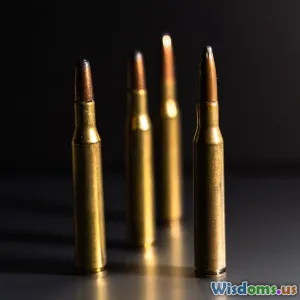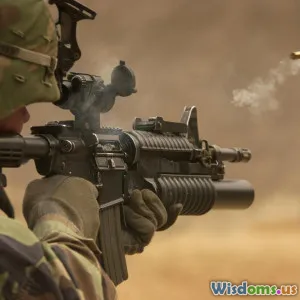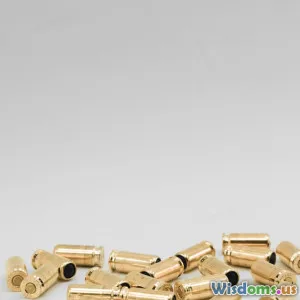
Why Similar Firearms Leave Different Marks on Bullets
14 min read Explore how seemingly identical firearms leave unique marks on bullets, uncovering the science and forensics behind these crucial ballistic signatures. (0 Reviews)
Why Similar Firearms Leave Different Marks on Bullets
Introduction: A Silent Signature Written in Steel
Imagine two pistols, fresh from the same manufacturing line, indistinguishable to the naked eye. Each fires the same brand of bullets under identical conditions—but on inspection, the fired bullets bear marks as unique as fingerprints. These microscopic etchings provide crucial evidence in countless crime scene investigations, but what makes each gun's 'signature' so inimitable, even among siblings off the assembly line? This fascinating question forms the backbone of forensic ballistics as well as countless criminal convictions and exonerations.
As General Jules Méline once quipped, “A bullet never lies.” It’s not just melodrama: the tiny scars and grooves scratched onto every expelled bullet can point directly to the specific firearm that discharged it. Yet, even similar or consecutive firearms never mark the same way. Join us as we unlock the science and stories behind these ballistic signatures and reveal how the hidden history of a gun writes itself onto every projectile it fires.
The Anatomy of Firearm Markings
What Are Firearm Toolmarks?
At its core, every firearm is a crafted tool. The toolmarks are the empirical result of hard metal encountering soft lead (or copper-jacketed) projectiles, as the firearm utilizes explosive force to propel bullets down a precisely engineered path: the bore. The resulting marks fall into two categories:
-
Class Characteristics: These are features inherent to a firearm model or brand—such as the number, width, and twist of a barrel’s rifling lands and grooves. All guns of the same make and model will generally share these traits.
-
Individual Characteristics: The minute, almost random imperfections, wear, and alterations that occur during manufacturing, usage, cleaning, or repairs. It is these subtleties that ensure even 'identical' firearms never mark a bullet quite the same way.
Both sets of characteristics are central to both the craft of firearms design and the investigative science called forensic ballistics.
The Path of a Bullet: From Chamber to Muzzle
When a bullet is fired, it endures remarkable forces and encounters several unique surfaces in rapid succession:
- Breech Face and Firing Pin: The breech locks the cartridge in place, while the firing pin leaves an impression on the primer cap.
- Extraction and Ejection: Semi-automatic firearms force spent casings against the extractor and ejector, marking them distinctively.
- Barrel Rifling: Most critical for bullet examination—the process of rifling (engraving spiral grooves inside the barrel) causes the bullet to spin, stabilizing its flight and accuracy. These grooves, and the lands between them, engrave microscopic striations onto the bullet surface.
Each surface, shaped and worn by manufacturing processes and time, imprints distinct evidence on the bullet.
Inside the Manufacturing Process: The Origin of Difference
Rifling: Born to Be Unique
Virtually all modern firearms barrels are produced using rifling—helical grooves cut or pressed inside the bore. How these grooves are made varies by technique:
- Cut Rifling: A cutting tool is used to incrementally slice grooves in a steel blank. Each pass may produce slight chattering or geometric variances.
- Button Rifling: A hard tool is forced through the barrel, imprinting grooves through displacement. Button wear over time slightly alters groove shape.
- Hammer Forging: The barrel blank is hammered around a mandrel with rifling impressions, potentially introducing subtle irregularities.
Even with cutting-edge CNC machines, minute vibrations, tool wear, temperature fluctuations, and metal inconsistencies ensure that the resulting rifled barrels are individually distinct—even if produced in the same batch. The National Institute of Justice notes, “Microscopically, no two firearms barrels—even those manufactured in succession—will have identical surface characteristics.”
Real-World Example: Forensics in the Boston Marathon Bombing
In the investigation following the tragic 2013 Boston Marathon bombing, forensic experts matched spent shell casings and bullets from law enforcement shootouts to the attackers' guns using these unique toolmarks, despite the firearms being otherwise mass-produced and similar to those possessed by police. The case showcased how even small individual characteristics can definitively link particular firearms to events.
Wear and Tear: Guns Age Like People
Every bullet fired, every cleaning brush, every accidental ding or deliberate modification gradually transforms the microscopic landscape of a firearm's interior. Two identical pistols—a model 1911, for example—diverge in their ‘personalities’ as they gain mileage:
- Barrel Wear: Heating, fouling, or abrasive particles gradually erode sharp lands, round off edges, or create new micro-defects.
- Cleaning Damage: Metallic or improper cleaning rods can scratch rifling, changing the bullet markings with each session.
- User Modifications: Gunsmithing, accidental drops, or repairs (intentional or otherwise) introduce new toolmarks, often unique to a specific firearm.
Case Insight: The Notorious St. Valentine's Day Massacre (1929)
Forensic pioneer Calvin Goddard utilized bullet and cartridge comparisons to match weapons to the murder of seven gang members. Over time, he proved that one Tommy gun, through distinctive markings, was the exact weapon used in an earlier police ambush. Toolmark distinctions separated dozens of identical Tommy guns in circulation.
The Human Element: Manufacturing Imperfections and Hand Finish
Mass production has improved vastly, but humans still play pivotal roles—whether in final quality control inspections, hand-polishing, or repairs. The pressure applied, the sequence of passes, even the sharpness of the eye on the assembly floor all impart micro-variations.
- Final Finishing: A quick polish might round a land’s edge more on one side than another.
- Tool Replacement: A rifling broach exchanged mid-batch might carve slightly shallower or sharper grooves.
- Variations Within Tolerance: Manufacturers allow slight deviation if within safety margins, meaning ‘identical’ parts can vary subtly between guns.
These realities ensure no two guns, no matter how alike externally, are truly identical within.
The Bullet’s Journey: Recording Every Encounter
Bullets: The Clay of Firearm Forensics
Bullets today vary widely in shape, size, and material. A soft lead .38 Special will record barrel marks more clearly than a hard copper-jacketed .223 round fired at high velocity. Even irregular manufacturing or visible flaws in the bullet itself can accentuate or obscure certain marks.
Key Factors Affecting Markings:
- Bullet Composition: Softer metals are more easily engraved by the barrel’s surfaces.
- Velocity and Pressure: High-velocity rounds may strip, abrade, or erase shallow marks, while slower ones may capture finer scratches.
- Ammunition Variability: Factory rounds vs. hand-loaded ammunition can influence how well a bullet ‘records’ surface toolmarks, due to subtle size or pressure variances.
Signature Retrieval: Tools of the Trade
Forensic experts utilize:
-
Comparison Microscopes: Allow two fired bullets to be examined side-by-side for matching striations.
-
Ballistic Imaging Systems: National databases like NIBIN (National Integrated Ballistics Information Network) catalog and compare millions of images, helping investigators connect crimes in disparate jurisdictions.
Quote:
“The uniqueness of every firearm’s effects on bullets and cartridge cases has transformed ballistic evidence into one of the cornerstones of modern forensic science.” — Dr. Christopher Monturo, Ballistics Expert
Not Just the Barrel: Cartridge Case Markings and Other Clues
While bullet striations receive the spotlight, shell casings pulled from crime scenes often feature unique marks themselves—useful when a fired bullet is too damaged for comparison.
- Firing Pin Impressions: The impact dimple on the primer left by the firing pin, often with microscopic irregularities.
- Breech Face Marks: The texture stamped onto the base of the cartridge upon ignition.
- Extractor and Ejector Marks: Metal edges scrape and nick the case uniquely, especially in semi-automatic firearms.
Real-World Case: The Beltway Snipers (2002)
Ballistic analysis of spent shell casings and bullets from various scenes allowed the FBI to link shootings committed by the snipers even when distances and circumstances varied. Subtle differences and matching toolmarks led to conclusive identification of the serial killer’s Bushmaster rifle.
How Forensics Harnesses This Uniqueness: Concrete Examples
Ballistics investigation is responsible for solving countless high-profile cases. The uniqueness of each gun’s ‘signature’ is a reliable bedrock of evidence—provided marks are clear and expertise applied:
Success Story: Matching the Unmatchable
In 2004, firearms examiners in Phoenix matched a bullet from a deadly drive-by to a recovered pistol. Initially, skepticism was high: dozens of similar guns plausibly existed in the city. However, a particular deep scratch along one land mark—caused by a cleaning mishap, perhaps—provided the ‘smoking gun’ link, separating this pistol from every other .40 caliber in evidence.
Limitations and Cautions
Ballistics is not infallible. Damage, over-cleaning, or intentional modification (by those wishing to obscure a firearm’s history) can render markings ambiguous. High deformity projectiles, such as hollow-points used in self-defense, may become too mangled for confident analysis. Still, when bullets survive in good condition, individual characteristics—awash with the history of manufacturing, use, and care—often provide conclusive physical evidence.
The Future: Advances in Identification
Newer technologies are already enhancing, and in some cases challenging, traditional comparisons:
- 3D Surface Mapping: Instead of simple visual inspection, laser scanning and computer models record three-dimensional toolmark landscapes, improving accuracy and repeatability.
- Machine Learning: Some research efforts apply pattern recognition and AI to massive national ballistics databases, automatically flagging possible matches.
Nonetheless, the guiding principle remains—the uniqueness of surface toolmarks imprinted with every shot.
Conclusion: Every Gun Tells Its Own Story
Why do similar firearms leave different marks on bullets? The answer lies not in broad similarities but in hidden complexities: the chaotic beauty of manufacturing, the quirks of use, the passage of time, and the microscopic scars left by every collision between metal and metal. Every firearm, like every person, is a sum of its origins, experiences, and imperfections.
For investigators and scientists, these differences write a metal ‘paper trail’ that can return justice, exonerate the innocent, and unravel the most tangled of criminal mysteries. As technology advances, perhaps our ability to discern and measure these marks will only improve—but the principle remains unchanged. No two firearms, no matter how alike, ever truly walk the same path, and no two bullets ever bear the same story.
In every bullet exists a silent witness, and in every mark—a piece of truth, waiting to be read.
Rate the Post
User Reviews
Other posts in Forensic Science
Popular Posts

















